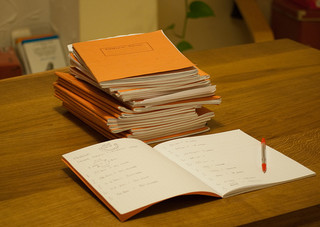 I have been marking this morning. Marking students work always teaches me something about my teaching, something about my students, and almost always leaves me mulling over the process and relationships involved learning and teaching. Having started the class with ‘Who I Am*’ a funky worksheet, I have already learnt an awful lot about my students, very quickly. Given that it is a low ability set, low in confidence and low self belief, I learnt even more from the questions they chose not to answer. Four students choose not to answer ‘My most memorable recent event’ and even when
I have been marking this morning. Marking students work always teaches me something about my teaching, something about my students, and almost always leaves me mulling over the process and relationships involved learning and teaching. Having started the class with ‘Who I Am*’ a funky worksheet, I have already learnt an awful lot about my students, very quickly. Given that it is a low ability set, low in confidence and low self belief, I learnt even more from the questions they chose not to answer. Four students choose not to answer ‘My most memorable recent event’ and even when encouraged pressed they choose not to answer.
Academically, I have been able to compare their first, albeit short written efforts, against their prior attainment and target grade, all very purposeful. I have a gauge of how the SENs might be met going forward.
Teaching, I try and always have two learning objectives. It immediately offers two opportunities to be successful in class, and a degree differentiation. The learning objectives often presented as learning activity (50+ ideas here) and are part of the instructional design. Sadly, I am either not giving students sufficient time to digest these and transfer them to their books, or I need to be more vigilant and get round the room even more and check.
Finally, assessment. Now we already know that assessment (feedback 1.13) has the greatest impact on student learning, even greater than teaching (instructional design) although I like to preface this with the added adjective ‘effective.’ Now effective feedback is difficult to construct. In my mind it is informative rather than evaluative, and how do you know students have engaged with feedback at all.
Dylan Wiliams does more than talk a good game, when it comes to feedback. If you lead or love learning and teaching, then visit his website. He very generously shares all his presentations there and it is well worth your time. I have no ambition to get on my assessment soap box here, but here are two vital points I remind myself most half terms.
Assessment should be more work for them, then it is for you.
Or as Dan Stucke puts it, ‘more work for recipient the than the donor.’ (And just for the record, the image is of Dan Stucke’s marking.)
Assessment leaves no mark in a book but leads to more learning.
For example ‘There are 4 spelling errors in the paragraph. Can you find them.’
These two points are even more important for ‘highly committed, dedicated teachers’ and ‘newly qualified teachers’ for whom marking can very quickly become a burden.
If it takes me fifteen minutes to mark the book, I set aside twenty minutes of the next lesson to act upon the feedback. It seems only fair.
Lastly, this morning, more be chance than judgement I stumbled upon another way to ensure I know students are reading the feedback. One student (MC) left me very little space at the bottom of a page to set a feedback task, so I turned book sideways and wrote north to south down the margin. I thought little of it, closed the book, placed it on the growing stack, and moved onto the next book. Later, I wanted to check what I had previously written, I had to turn the book to read it. Ahah – if I have to turn the book to read the feedback, they will have to turn the book to read the feedback, and I will know that they are reading the feedback.
Lastly mistakes. I have found that there is a casual correlation between promotion and the frequency with which you are expected to deal with student mistakes. Here is a strong closing line for one of those conversations.
When you make a mistake there are only three things you should ever do about it; admit it, learn from it and don’t repeat it. – Bear Bryant
[qr_code_display]
*I first used the worksheet when I taught at SIUE. I like the misspelling and ‘graduating’ terms, it encourages questions early on and I am not sure if I will change it.


Pingback: The Goldfish Bowl » More effective written feedback
Pingback: Dirty STAR | KristianStill/Blog